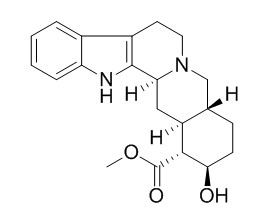beta-Yohimbine
Beta-Yohimbine has approximately twice as toxic as yohimbine and corynanthine about one fifth as toxic. Beta-yohimbine has alpha-1 and alpha-2 adrenoceptor blocking activities, it has cardiovascular effects. Beta-Yohimbine has anti-plasmodial and anti-malarial activity.
Inquire / Order:
manager@chemfaces.com
Technical Inquiries:
service@chemfaces.com
Tel:
+86-27-84237783
Fax:
+86-27-84254680
Address:
1 Building, No. 83, CheCheng Rd., Wuhan Economic and Technological Development Zone, Wuhan, Hubei 430056, PRC
Providing storage is as stated on the product vial and the vial is kept tightly sealed, the product can be stored for up to
24 months(2-8C).
Wherever possible, you should prepare and use solutions on the same day. However, if you need to make up stock solutions in advance, we recommend that you store the solution as aliquots in tightly sealed vials at -20C. Generally, these will be useable for up to two weeks. Before use, and prior to opening the vial we recommend that you allow your product to equilibrate to room temperature for at least 1 hour.
Need more advice on solubility, usage and handling? Please email to: service@chemfaces.com
The packaging of the product may have turned upside down during transportation, resulting in the natural compounds adhering to the neck or cap of the vial. take the vial out of its packaging and gently shake to let the compounds fall to the bottom of the vial. for liquid products, centrifuge at 200-500 RPM to gather the liquid at the bottom of the vial. try to avoid loss or contamination during handling.
Plant Biotechnology Reports 2021, 15:117-124.
Univerzita Karlova2022, 173245.
J Agric Food Chem.2024, acs.jafc.4c01387.
J Ginseng Res.2023, 47(4):572-582.
Horticulture Research2023, uhad164.
J Agric Food Chem.2020, 68(51):15164-15175
Food Chemistry: X2023, 101032.
Food Research2022, 6(6): 30-38.
Chinese Pharmacological Bulletin2019, 35(8):1120-1125
Antioxidants (Basel).2023, 12(2):447.
Related and Featured Products
Molecules. 2013 May 29;18(6):6281-97.
Chemical composition of Aspidosperma ulei Markgr. and antiplasmodial activity of selected indole alkaloids.[Pubmed:
23760029]
METHODS AND RESULTS:
A new indole alkaloid, 12-hydroxy-N-acetyl-21(N)-dehydroplumeran-18-oic acid (13), and 11 known indole alkaloids: 3,4,5,6-tetradehydro-β-yohimbine (3), 19(E)-hunteracine (4), beta-Yohimbine(5), yohimbine (6), 19,20-dehydro-17-α-yohimbine (7), uleine (10), 20-epi-dasycarpidone (11), olivacine (8), 20-epi-N-nor-dasycarpidone (14), N-demethyluleine (15) and 20(E)-nor-subincanadine E (12) and a boonein δ-lactone 9, ursolic acid (1) and 1D,1O-methyl-chiro-inositol (2) were isolated from the EtOH extracts of different parts of Aspidosperma ulei Markgr. (Apocynaceae). Identification and structural elucidation were based on IR, MS, ¹H- and ¹³C-NMR spectral data and comparison to literature data. The antiplasmodial and antimalarial activity of 1, 5, 6, 8, 10 and 15 has been previously evaluated and 1 and 10 have important in vitro and in vivo antimalarial properties according to patent and/or scientific literature. With the aim of discovering new antiplasmodial indole alkaloids, 3, 4, 11, 12 and 13 were evaluated for in vitro inhibition against the multi-drug resistant K1 strain of the human malaria parasite Plasmodium falciparum. IC₅₀ values of 14.0 (39.9), 4.5 (16.7) and 14.5 (54.3) mg/mL (mM) were determined for 3, 11 and 12, respectively. Inhibitory activity of 3, 4, 11, 12 and 13 was evaluated against NIH3T3 murine fibroblasts.
CONCLUSIONS:
None of these compounds exhibited toxicity to fibroblasts (IC₅₀ > 50 mg/mL). Of the five compounds screened for in vitro antiplasmodial activity, only 11 was active.
Psychopharmacology (Berl). 1977 Jan 31;51(2):209-12.
Interaction between yohimbine alkaloids and amphetamine in mice.[Pubmed:
402675]
METHODS AND RESULTS:
The toxicity (LD50) of the isomers yohimbine, beta-Yohimbine, and corynanthine was determined in mice. The LD50 of amphetamine in the presence of a constant dose of a yohimbine isomer and that of the isomer in the presence of a constant dose of amphetamine were determined in aggregated mice. Isobolograms were constructed from these data and used to evaluate the interaction of the yohimbine alkaloids and amphetamine. beta-Yohimbine was found to be approximately twice as toxic as yohimbine and corynanthine about one fifth as toxic. There was a mutual potentiation between the toxicities of yohimbine and amphetamine. Potentiation of the toxicity of amphetamine occurred with beta-Yohimbine but the effect was not as marked as with yohimbine. In contrast, corynanthine antagonized the toxicity of amphetamine.
CONCLUSIONS:
The interaction between yohimbine and amphetamine is unlikely to be due to noradrenergic mechanisms but could conceivably involve serotonergic or dopaminergic mechanisms.
Chem Pharm Bull (Tokyo). 1990 Jun;38(6):1702-6.
Structure-activity relationship of yohimbine and its related analogs in blocking alpha-1 and alpha-2 adrenoceptors: a comparative study of cardiovascular activities.[Pubmed:
1976443]
We investigated the selectivities and structure requirements for alpha-1 and alpha-2 adrenoceptor blocking activities of yohimbine (YO) and its 12 related analogs, such as beta-Yohimbine (beta-YO), dihydrocorynantheine (DHC) and (-)indoloquinolizidine ((-)IQ).
METHODS AND RESULTS:
The affinity of YO analogs to alpha-adrenoceptor was assessed by measuring their blockade of pressor responses to epinephrine in pithed rats. Among YO structure groups, the potency order was YO greater than DHC = beta-YO greater than geissoschizine methylether greater than 14 beta-hydroxy YO greater than 14 beta-benzoyloxy YO (inactive). (-)IQ was slightly less potent than YO, but much stronger than (+)IQ. Among (+/-)IQ structure groups, the potency order was (+/-)IQ greater than (+/-)1,12b-trans-1-hydroxy IQ much greater than (+/-)1,12b-cis-1-hydroxy IQ (inactive). (+/-)Borrerine was active, but (+/-)desmethylborrerine was inactive. The alpha-1 blocking activities of the four compounds YO, beta-YO, DHC and (-)IQ, were assessed in experiments of pressor responses to methoxamine in pithed rats and contractile responses to methoxamine in the rat vas deferens. The potency order was (-)IQ greater than YO greater than DHC greater than beta-YO. Furthermore, the alpha-2 blocking activities of the four analogs were assessed in experiments of pressor responses to clonidine and inhibition of electrically driven cardioacceleration by clonidine, in pithed rats. The potency order was YO greater than beta-YO greater than (-)IQ greater than DHC.
CONCLUSIONS:
Based on the potency ratio between alpha-1 and alpha-2 blocking activities, DHC or YO was most selective for alpha-1 or alpha-2 subtype, respectively, among the four YO analogs.



